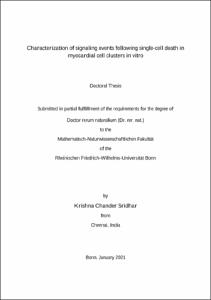Characterization of signaling events following single-cell death in myocardial cell clusters in vitro

Characterization of signaling events following single-cell death in myocardial cell clusters in vitro

| dc.contributor.advisor | Merkel, Rudolf | |
| dc.contributor.author | Sridhar, Krishna Chander | |
| dc.date.accessioned | 2021-05-26T14:34:24Z | |
| dc.date.available | 2021-05-26T14:34:24Z | |
| dc.date.issued | 26.05.2021 | |
| dc.identifier.uri | https://hdl.handle.net/20.500.11811/9108 | |
| dc.description.abstract | Cell death is a characteristic feature of acute and chronic cardiac pathologies such as myocardial infarction, ischemia-reperfusion and heart failure. Cardiomyocytes (CMs) death triggers myocardial remodeling that may lead to myocardial dysfunction over time. Although pathways of CM death in myocardial tissue have been described previously, spontaneous signaling events following CM death and the response of connected cells to these signals are not clearly understood. Elucidating cell death signaling mechanisms in myocardial tissue is essential to develop strategies to mitigate/alleviate myocardial damage. In this work, spontaneous signaling events were characterized in cultured rat embryonic myocardial cells upon single-cell death triggered by laser ablation. The dynamic changes in cells were studied based on spatial and temporal changes in Ca2+ concentrations ([Ca2+]) using the Fluo-4 AM Ca2+ indicator. Laser-induced death of single CMs resulted in an increased [Ca2+]i in CMs and fibroblasts (Fbs) surrounding the ablated cell in coculture clusters. [Ca2+]i-increase followed completely different patterns in CMs and Fbs. Whereas in CMs the increase was slow and sustained, it was a single, fast and transient [Ca2+]i spike in Fbs. Moreover, the increased [Ca2+]i resulted in a briefly interrupted contractility in CMs that recovered with time. The cell-type (CM/Fb) specific effect was confirmed by analyzing ablation-induced cell death in separate cultures of CMs and Fbs obtained from a fusion-based magnetic cell separation method. The [Ca2+]i-increase in CMs following ablation was found to be distance-dependent as CMs that were closely connected to the ablated cell was highly affected by Ca2+ inflow compared to the farther located CMs (>100 μm), whose contractility remained largely unaffected. Comparing the radial Ca2+ propagation speeds along CMs and Fbs showed significantly faster propagation speeds (~ 20 μm/s) in Fbs compared to those in CMs (5 – 10 μm/s). Further, [Ca2+]i-increase as well as [Ca2+]i recovery times post ablation in CMs and Fbs were significantly different and hence argued for a different Ca2+ propagation and handling in these cell types. High-resolution analysis of Ca2+ propagation in CMs showed a sequential diffusion of Ca2+ from ablated cell to connected cells along the cell-cell contacts. Moreover, immunocytochemical analysis showed the presence of gap junction protein connexin43 (Cx43), localized at junctions of adjacent CMs. This suggested a gap junction-mediated flow of Ca2+ between CMs upon ablation. However, in Fbs, lack of direct Ca2+ flow along the connected cells, absence of gap junction proteins (Cx40, Cx43, and Cx45), faster and almost constant propagation speeds indicated a putative membrane potential-driven propagation of Ca2+ upon ablation. Simultaneous analysis of Ca2+ and traction force changes in CM clusters on soft substrates (15 kPa) confirmed the direct link between [Ca2+]i-increase and disrupted contractility of surrounding CMs following ablation. Analysis of the effects of ablation on patterned growth of CMs and Fbs showed that single CM death in a cluster of CMs resulted in briefly delayed contractile beats in CMs cluster at the other end of a ~ 500 μm wide fibroblast-bridge. Taken together, this research work illustrates the spontaneous Ca2+ signaling events following laser-induced single-cell death and the response of both CMs and Fbs to these signals. The study also describes the Ca2+-based functional connectivity between CMs and Fbs in myocardial cell clusters. | en |
| dc.language.iso | eng | |
| dc.rights | In Copyright | |
| dc.rights.uri | http://rightsstatements.org/vocab/InC/1.0/ | |
| dc.subject | Myocardial injury | |
| dc.subject | Cell death | |
| dc.subject | Laser ablation | |
| dc.subject | Calcium signaling | |
| dc.subject | Cell-cell communication | |
| dc.subject.ddc | 540 Chemie | |
| dc.title | Characterization of signaling events following single-cell death in myocardial cell clusters in vitro | |
| dc.type | Dissertation oder Habilitation | |
| dc.publisher.name | Universitäts- und Landesbibliothek Bonn | |
| dc.publisher.location | Bonn | |
| dc.rights.accessRights | openAccess | |
| dc.identifier.urn | https://nbn-resolving.org/urn:nbn:de:hbz:5-62394 | |
| ulbbn.pubtype | Erstveröffentlichung | |
| ulbbnediss.affiliation.name | Rheinische Friedrich-Wilhelms-Universität Bonn | |
| ulbbnediss.affiliation.location | Bonn | |
| ulbbnediss.thesis.level | Dissertation | |
| ulbbnediss.dissID | 6239 | |
| ulbbnediss.date.accepted | 07.05.2021 | |
| ulbbnediss.institute | Mathematisch-Naturwissenschaftliche Fakultät : Fachgruppe Chemie / Institut für Physikalische und Theoretische Chemie | |
| ulbbnediss.fakultaet | Mathematisch-Naturwissenschaftliche Fakultät | |
| dc.contributor.coReferee | Kubitscheck, Ulrich | |
| ulbbnediss.contributor.orcid | https://orcid.org/0000-0001-8108-7627 | |
| ulbbnediss.contributor.gnd | 1235772780 |
Files in this item
This item appears in the following Collection(s)
-
E-Dissertationen (4074)




